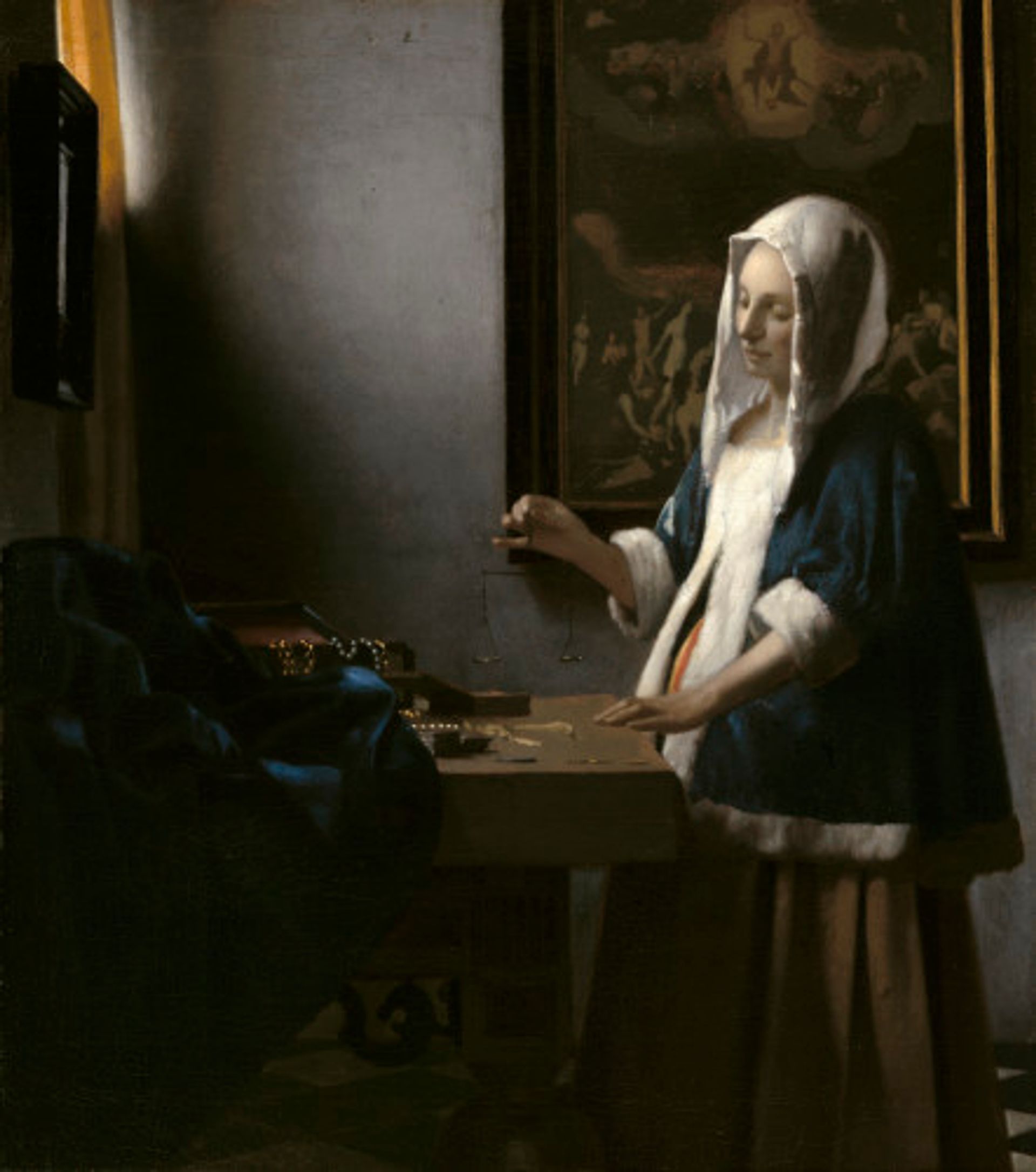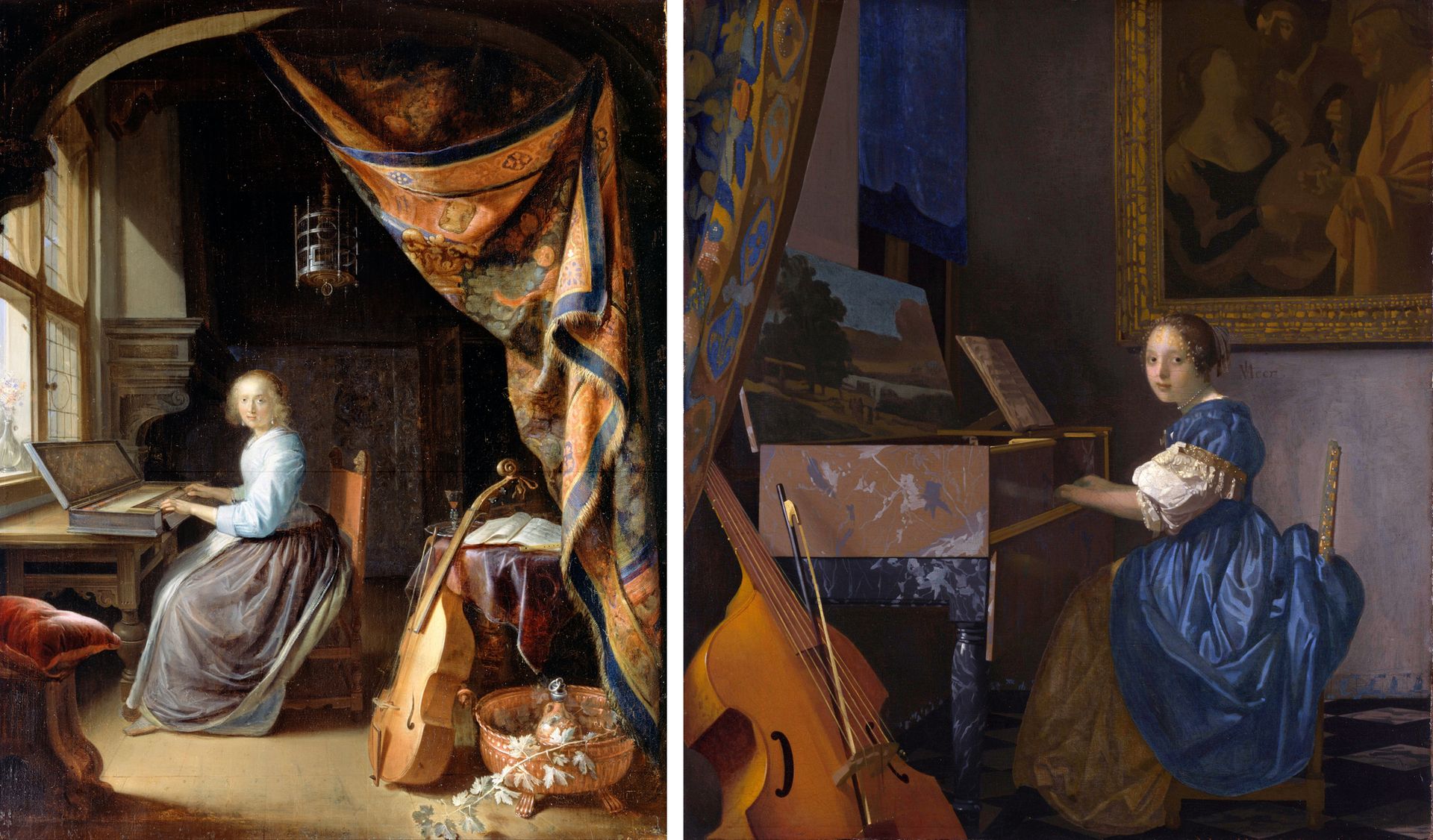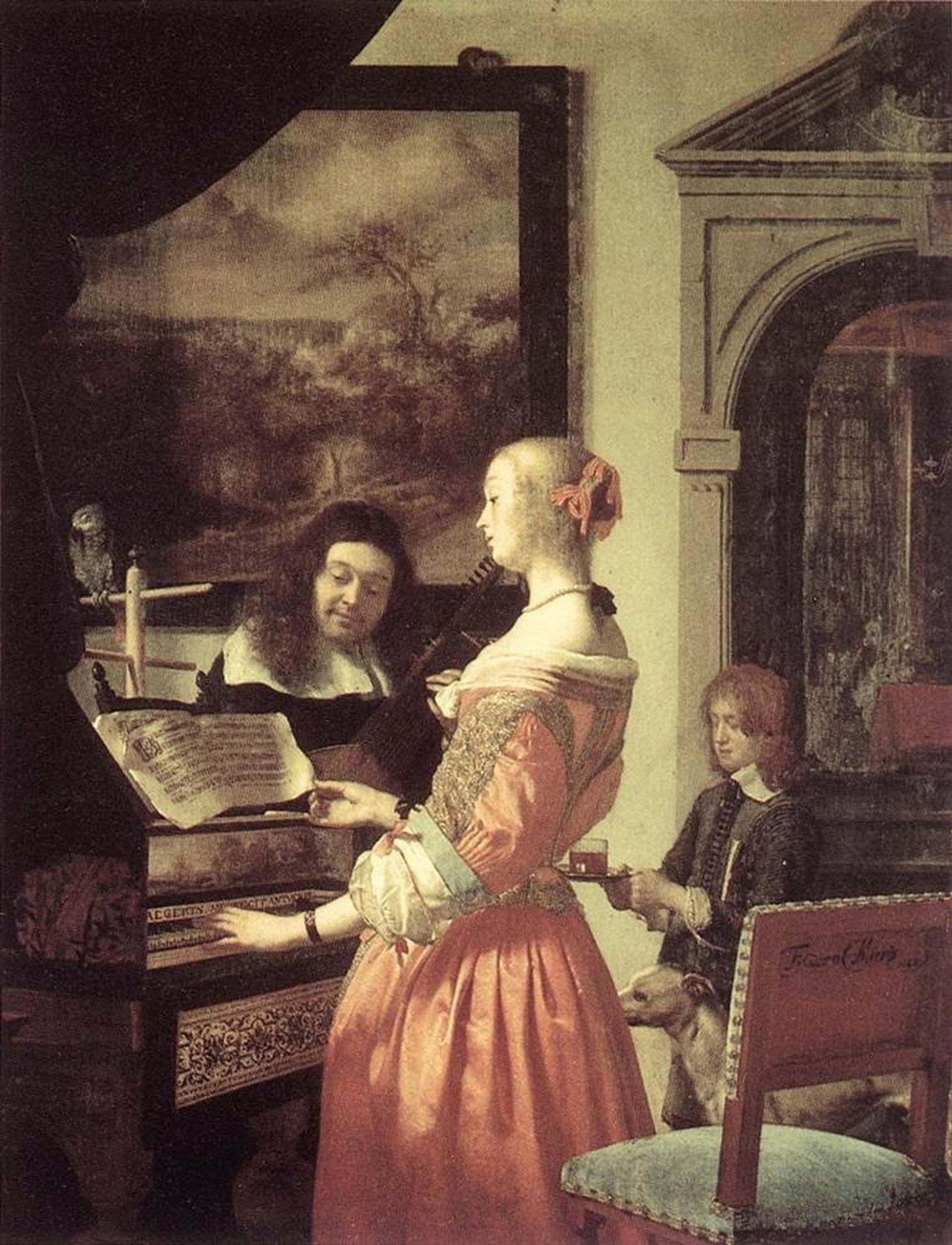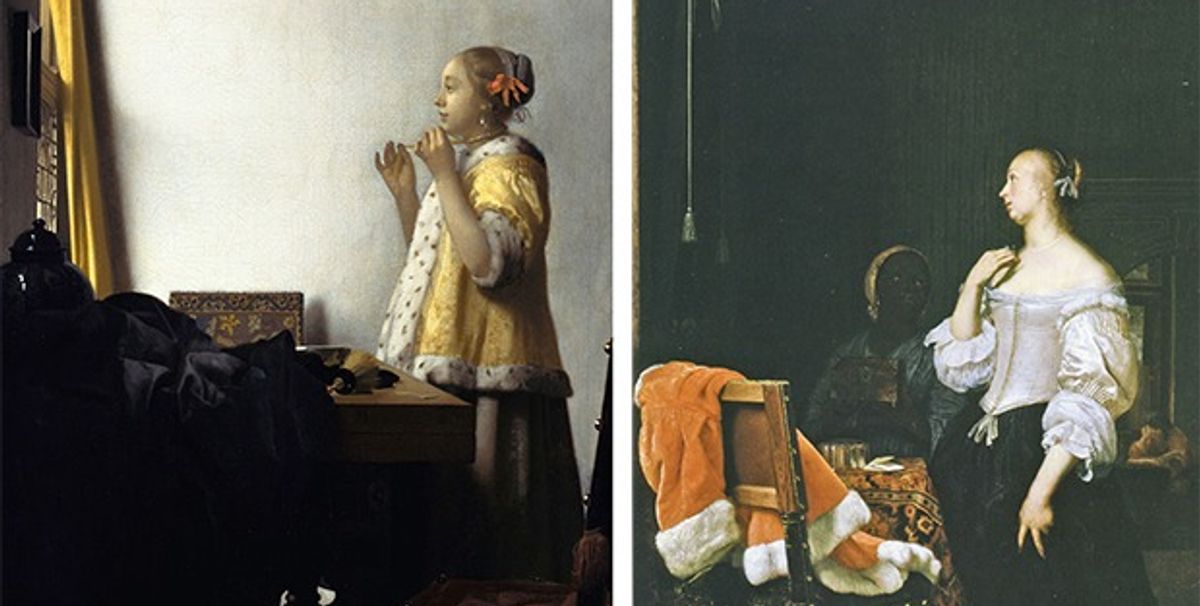This month, the National Gallery of Ireland in Dublin fully re-opens after a six-year refurbishment during which most of its galleries were closed. As part of the celebration, the museum will host Vermeer and the Masters of Genre Painting (17 June-17 September), which closed at the Louvre in Paris in May. The show looks at the mutual influences between Vermeer and artists like Frans van Mieris and Gerard ter Borch, who often borrowed one another's ideas and compositions. In this excerpt from the exhibition catalogue (which is available through Yale University Press), the show's curator, Adriaan E. Waiboer, explains how the short distances between Dutch cities allowed for increased mobility, which greatly aided in the exchange of ideas.

Johannes Vermeer’s Woman with a Pearl Necklace (1662-65) offers a glimpse into the private realm of a young elegant lady. Staring at her own image in a mirror, she ties the ribbons of a pearl necklace. She wears a jacket that modern-day viewers have come to recognise as one of Vermeer’s trademarks. This striking garment may well be identical to the "yellow satin mantle with white fur trimming" that was among the artist’s possessions described in his posthumous inventory. It is tempting to think therefore that the painting depicts Vermeer’s wife at her toilet. Our imagination conjures up images of Catharina Bolnes standing in her dressing room and putting on the coveted piece of jewellery in solitude. Quietly observing his wife from an adjacent room, Vermeer suddenly interrupts the silence: "Catharina, hold that pose! It’s brilliant . . . let me get some paper and a pencil . . . just don’t move!" The artist is obsessed with the image of a woman in a prolonged moment of quiet contemplation and is always on the lookout for inspiration in his own environment. This is perfect, Vermeer thinks, Catharina putting on a pearl necklace will be the subject of my next painting.
Attractive as this scenario may sound, Vermeer’s principal source of inspiration was not a serendipitous encounter at his home in Delft. Rather, it was a trip the artist made to Leiden, where he admired Frans van Mieris’s Woman before a Mirror. Completed one or two years earlier, this painting also depicts a female figure in profile putting on a piece of jewellery. In both paintings the women stand in front of a table with a chair in the foreground serving as a repoussoir. The play of contrasting vertical and horizontal lines in both paintings is so similar that there is little doubt that Van Mieris’s picture, rather than Catharina’s morning toilet, inspired Vermeer to paint Woman with a Pearl Necklace. Yet Van Mieris had not spontaneously asked his wife, Cunera van der Cock, to hold her pose either. The Leiden painter, in turn, had drawn inspiration from Young Woman at her Toilet with a Maid by Gerard ter Borch. Some ten years earlier, this artist from Deventer had painted a lady standing in front of the mirror, similarly engrossed, fiddling with an accessory—not a necklace, but a bow of her corset. Ter Borch had represented her full- instead of three-quarter length, and had depicted her looking to the right rather than the left. Yet the overall similarities in subject, composition and figure poses indicate that Van Mieris had studied Ter Borch’s painting in preparation for his own.
Vermeer, Van Mieris and Ter Borch’s masterpieces are representative of many genre scenes painted during the third quarter of the 17th century. These works appear so natural and lifelike that they give the impression that the figures, objects and architectural settings depicted were in front of the artists’ eyes when they captured them in paint. Comparisons with contemporary pictures, however, frequently reveal similarities in style, subject matter and technique that cannot be coincidental, suggesting that artists regularly studied, admired and drew inspiration from each other’s paintings. More so, these genre painters often tried to surpass each other’s works in verisimilitude, technical prowess and aesthetic appeal. This vibrant artistic rivalry contributed to the exceptionally high quality of their combined oeuvre. Bringing together nearly eighty genre scenes of the period 1650–75 from across the world, this exhibition aims to provide insight into this fascinating network of relationships between Vermeer and contemporary genre painters.
The third quarter of the 17th century marks the apogee of Dutch genre painting. This period saw the rise and flourishing of scenes of domestic life intimately portraying the mundane tasks and activities of men and women and, above all, the leisurely pastimes of the highest echelons of society. The unprecedented quality and popularity of these highlife scenes was the result of a confluence of economic, social and artistic developments around 1650. While the financial strength of the Dutch Republic had begun to decline by the middle of the century, a minority of (mostly interrelated) merchant families, most of whom resided in the principal cities in the province of Holland, continued to amass unparalleled fortunes. These well-heeled individuals felt an increasing need to distinguish themselves in terms of civility as well as material luxury. Subscribing to codes of dress, manners and speech, they desired a type of high-end art that was in line with their own self-image. The genre scenes of Vermeer’s generation met this demand, as they were more opulent, sophisticated and technically superior than most of what had been hitherto produced in the northern Netherlands.

The economic and artistic booms were fragile, however. Rivalries with England led to three naval wars, which had a severe negative impact on the art markets of cities other than Amsterdam. The third battle with England coincided with the start of the Dutch–Franco war in 1672. Assisted by England, Sweden, the Bishopric of Münster and the Archbishopric of Cologne, King Louis XIV of France occupied large parts of the United Netherlands. During 1672, known among the Dutch as "the year of disaster", the economy of the Seven Provinces plummeted. With the county virtually on its knees, many artists went bankrupt. The Dutch Golden Age and the zenith of genre painting came largely to an end.
The "new wave" of Dutch genre painting emerged in the early 1650s when a handful of portrait and figure painters, among them Jacob van Loo, Gerbrandt van den Eeckhout and Ter Borch, began painting genre scenes in which they gradually reduced the number of figures, substituted oblong format supports with upright ones, and preferred representing the pastimes of elegant ladies and gentlemen more intimately, tranquilly and with more dignity than their predecessors. While Van Loo and Van den Eeckhout’s preference ultimately remained with biblical and mythological imagery, Ter Borch became a pivotal figure in the field of genre painting after 1650, introducing many new subjects, compositions and motifs readily adopted by younger artists. Gerrit Dou from Leiden had, at the start of his career, painted portraits and genre scenes featuring elderly men and women, but around 1650 he began representing young attractive women engaged in various activities and figures in open windows. These paintings served as inspiration to several artists in- and outside his hometown. Dou’s mesmerising "fine" painting technique, moreover, allowed him to attract prestigious clients and command prices to which virtually every other genre painter in the northern Netherlands could only aspire.
Broadly speaking, Ter Borch and Dou paved the way for a number of artists born between 1620 and 1635, who either trained with them or had started their careers painting biblical, mythological or guardroom scenes, but switched to depicting domestic life over the course of the 1650s. These painters, however, also drew heavily on each other’s works. Dou’s pupil Van Mieris, for example, took the delicate brushwork of his master to a more meticulous level, blending it with the genteel interactions inspired by Ter Borch. Yet Van Mieris also appropriated ideas from the work of Pieter de Hooch, Gabriel Metsu, Nicolaes Maes, Jacob Ochtervelt and Caspar Netscher. Netscher’s genre scenes initially strongly depended on those of his teacher, Ter Borch, but began gradually reflecting his interest in Dou, Van Mieris and Vermeer’s paintings. While Vermeer’s representation of light and space was indebted to developments in Delft, most of his subjects, figures and compositions were variations of Ter Borch’s and Dou’s, as well as Maes, Van Mieris and De Hooch’s paintings. De Hooch blended ideas taken from Rotterdam and Delft paintings with those from the work of Ter Borch as well as Van Mieris, Vermeer and Metsu. Metsu’s eclectic oeuvre was strongly dependent on works by Ter Borch and Dou, but also includes references to those by De Hooch, Maes, Vermeer, Van Mieris and Jan Steen. Steen, finally, painted in addition to dissolute households, proverbs and cheerful companies many domestic genre scenes that reveal his admiration for Ter Borch and Dou’s paintings, but also those of De Hooch, Van Mieris, Metsu and Vermeer.
These examples suggest that many of the interactions between Dutch genre painters occurred between first-rate artists of more or less equal status, rather than an abundance of artists responding to a handful of more talented pioneers. Furthermore, it appears that several genre painters drew inspiration from each other’s works. De Hooch’s brightly lit interiors, for instance, proved to be of great significance for some of Vermeer’s earliest genre scenes. After the former moved to Amsterdam, however, he adopted a number of subjects and compositions from works by the latter, who still lived in Delft. Furthermore, the relationships described above suggest that these artists did not find their inspiration solely in the work of older painters, as one might expect. In fact, they frequently took the works of those who were five to ten years younger as their point of departure. Even Ter Borch and Dou began at some stage of their careers responding to those whom they had inspired themselves several years earlier. In the 1660s, the former began appropriating ideas from paintings by Vermeer and Maes, who were 15 and 17 years his junior, respectively. Around the same time, Dou drew inspiration from the work of Van Mieris, who was no less than 22 years younger.

The frequent interactions between genre painters resulted in an extraordinarily large number of relationships between individual works of art. More than a thousand connections have been recorded between the genre scenes of the 17 leading artists in the field during the period 1650–75. While some innovations inspired only a single artist, others made an impact on a wide range of painters. Dou’s paintings with figures in open windows, for instance, reverberated with both Leiden painters as well as those living further afield, including Metsu, Netscher, Maes, Eglon van der Neer and Godefridus Schalcken. Some of Van Mieris’s iconic compositions, such as The Duet (1658), Brothel Scene (around 1658-59), Man and Woman with Two Dogs (Teasing the Pet) (1660), The Oyster Meal (1659) and Woman Feeding a Parrot (1663), served as inspiration to Steen, Metsu, Vermeer, Van der Neer, Ochtervelt, Netscher, Michiel van Musscher, Quiringh van Brekelenkam and Cornelis Bega. Ter Borch’s ladies in satin had a ripple effect on virtually every painter of domestic genre scenes active in Holland in the 1660s.
Looking at these connections today may prompt the thought that the artists’ familiarity with each other’s works was the result of their living in the same neighbourhood or being members of the same guild. However, they resided in different cities in the Dutch Republic, which suggests that artists (and their works of art) travelled extensively. Anyone who has visited the Netherlands knows that the distances between the major cities are relatively small. This is certainly true for those located in the western province of Holland, such as Amsterdam, Haarlem, Leiden, The Hague, Delft, Rotterdam and Dordrecht, where nearly all major genre painters lived. People travelled between these towns by coach, wagon, horse or on foot. One could also use the trekschuit (horse-drawn barge), which allowed for comfortable and punctual travel. The system of trekschuiten had become so efficient by the late 1650s that one could travel from Rotterdam to Delft in one hour and 45 minutes, every hour; from Delft to The Hague in one hour and 15 minutes, every half an hour; from Leiden to Haarlem in two hours, nearly every hour; and from Haarlem to Amsterdam in one hour and 15 minutes, every hour. Contemporary diaries of Dutch and foreign travellers illustrate how far people travelled by trekschuit in a day. The landscape painter Willem Schellinks, for example, mentioned that on a summer’s day in 1661 he left Amsterdam in the morning to visit acquaintances in Haarlem. After his meeting, he took a horse-drawn barge, which brought him first to Leiden and then to nearby Zoeterwoude, where his party took a coach to pause at a local country house. In the early evening he took the trekschuit to The Hague, where he arrived at ten o’clock.
Relatively few archival documents have survived confirming that the genre painters under discussion made such sojourns to other towns. However, diaries such as Schellinks’s suggest that Vermeer, for instance, could easily have visited Van Mieris and Dou in Leiden for the day and that Metsu could have travelled from Amsterdam to Dordrecht to see Maes in one day and returned home the next. The only artist who required longer travelling time was Ter Borch. Born in Zwolle in the province of Overijssel, he spent most of his mature career in nearby Deventer. Although there were few direct waterways between Deventer and towns in Holland during his lifetime, Ter Borch worked by no means in isolation: archival documents, contemporary literature and extant portraits reveal that he spent time in Amsterdam, Arnhem, Delft, Haarlem, Leiden, The Hague, Rotterdam and Utrecht—in addition to Antwerp, Brussels, Münster, London, Paris and Madrid.

The mobility of genre painters is further illustrated by the fact that the majority of them lived in more than one place over the course of their careers. Steen was particularly restless: he was born and raised in Leiden, furthered his education in Utrecht and/or Haarlem, took up residence in The Hague, then moved to Delft, went back to Leiden, stayed in the village of Warmond for some years, only to take up residence in Haarlem before eventually returning to Leiden during the last decade of his life. Most artists did not live in so many places, but, curiously, often tend to be associated with one in particular in art-historical literature. The "Delft" painter Pieter de Hooch, for instance, was born in Rotterdam, worked briefly in Leiden, then stayed for approximately eight years in Delft before settling down in Amsterdam, where he remained active for more than twenty years. The "Dordrecht" artist Maes spent more years of his artistic career in Amsterdam than in his native Dordrecht. Vermeer, Van Mieris and Cornelis Bega all lived in one place throughout their lives, but they have all been recorded outside their respective hometowns. Moreover, their extant paintings—certainly Vermeer’s—suggest that they regularly travelled to other Dutch towns to study works by other masters. Dou, finally, seems to have been the only home bird. Archival documents only place him in Leiden and nearby Bodegraven and few of his extant works suggest he travelled to draw inspiration from works by painters living further afield.
In spite of artists’ frequent moves across the northern Netherlands, a number of significant art-historical publications have classified Vermeer’s generation of artists according to the principal cities or described them as part of local "schools". This approach echoes the traditional interpretation of Italian art, which regards the collective artistic output of cities as individual scuole. The Dutch and Italian artistic situations, however, differed in many respects. For a start, it took far less time to travel between the major cities in the northern Netherlands than in Italy, leading to more frequent and intense exchanges and ultimately to less homogenous local styles of painting. Inhabitants of Dutch cities, however, did consider their artistic output as distinct from that of others, as evidenced by many contemporary stadsbeschrijvingen (town descriptions). These prestigious publications celebrate local artists to extol a city’s virtues above those of others. The numerous relationships between genre scenes painted in different Dutch cities, however, indicate that local pride did not preclude artists from frequently interacting with those from out of town. Stadsbeschrijvingen, though valuable historical and biographical sources, are not helpful in drawing art-historical demarcation lines.
A more valid reason for classifying genre painters by place is that some artistic developments in the field were indeed localised trends. Their significance, however, should not be overstated, as only two cities boasted a homogeneous production of genre scenes after 1650. In Leiden, many of Dou’s copious students stayed active locally after their training and remained faithful to their master’s subject matter and manner of "fine" painting. Van Mieris created his own repertoire, but continued his teacher’s tradition of meticulously painted panels. Dou and Van Mieris’s combined influence was omnipresent in Leiden and lasted into the early eighteenth century. Furthermore, Haarlem remained the centre of peasant imagery in the northern Netherlands after the middle of century. Most genre painters living in Haarlem either passed on the Bruegelian tradition or were somehow dependent on it. The remainder of Dutch cities, however, never boasted independently operating communities of genre painters after 1650. In Delft and Dordrecht a temporary synergy among a handful of painters resulted in a body of work that collectively looked differently from that of other towns. However, the number of artists involved was too small and the period during which they jointly flourished too short to maintain that these two cities had local "schools". Amsterdam, The Hague and Rotterdam never had a homogenous production of genre scenes, despite the fact that they were home to some of the most accomplished genre painters of their time, including De Hooch, Metsu, Netscher, Van der Neer and Ochtervelt. Utrecht, although a hotbed of genre painting during the first half of the seventeenth century, did not play any role in the field after 1650.
Adriaan E. Waiboer is the Head of Collections and Research at the National Gallery of Ireland
Vermeer and the Masters of Genre Painting, National Gallery of Ireland, Dublin, 17 June-17 September; travels to the National Gallery of Art, Washington, DC, 22 October-21 January 2018
From Vermeer and the Masters of Genre Painting: Inspiration and Rivalry by Adriaan E. Waiboer, with Arthur K. Wheelock Jr. and Blaise Ducos, et al; published by Yale University Press in association with the National Gallery of Ireland in 2017. Reproduced by permission.


